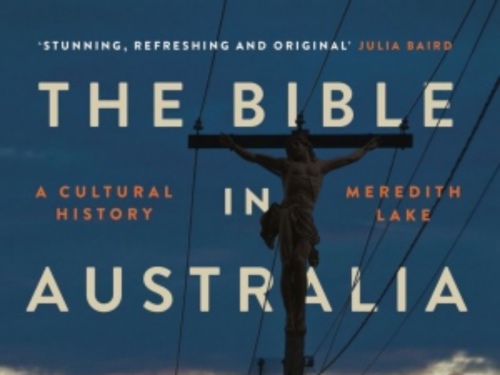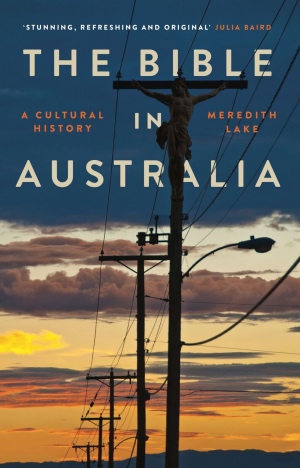
DAVID ADAMS reads historian Meredith Lake’s ‘The Bible in Australia: A Cultural History’…
Meredith Lake
The Bible in Australia: A Cultural History
NewSouth Publishing, 2018
ISBN-13: 978-742235714
I once had an argument with a fellow uni student in which I was advocating for the validity of studying the Bible, not as a sacred text (although for me it was and is), but simply in light of the impact it’s had on Australian society. I wish I’d had historian Meredith Lake’s book to hand.
Packed with fascinating stories showing the way in which the Bible has been appropriated in Australia, Lake’s wide-ranging cultural history of the Bible is an eminently readable survey of the impact the Good Book has had on the nation.
From the arrival of the first Bibles with European explorers – notably Englishman James Cook, whose surviving leather-bound Endeavour Bible is a sizeable tome, weighing almost four kilograms – Lake charts the impact on the lives of those who have lived here.

“Packed with fascinating stories showing the way in which the Bible has been appropriated in Australia, Lake’s wide-ranging cultural history of the Bible is an eminently readable survey of the impact the Good Book has had on the nation.”
Starting with populations of settlers and the Aboriginal people who were already here, she explores the key role the Bible has played in the formation of the nation of Australia, how it not only influenced opinions but shaped the very way in which society functions and responses to events like the two World Wars.
We read, of course, of the many church figures and missionaries like 19th century Christian activist and speaker Bessie Harrison Lee, 20th century church leaders like Sydney vicar RBS Hammond and contemporary leaders like Viv Benjamin, a former CEO of the anti-global poverty movement – the Oaktree Foundation, for whom the Bible has formed an integral part of their response to social issues.
There’s some illuminating chapters which also look at how the Bible impacted Indigenous communities – including the efforts made to translate the Bible into Indigenous languages. Again, it’s the stories of individuals that are used to shed light on the bigger picture – stories like those of Boorong, who lived with the family of Richard Johnson, the first clergyman in Australia, for 18 months and who later become the wife of the famous Bennelong, and that of Victorian Yorta Yorta man William Cooper who frequently employed Biblically-based arguments in advocating on behalf of his people.
“For some Indigenous converts, the Bible was a resource for processing the devastation of European invasion,” Lake writes. “For others, it was a focus for disagreements about the claims of Christianity and its impact in their community.”
We also read of how the Bible has influenced those who didn’t espouse a Christian faith – people like Australia’s second Prime Minister Alfred Deakin who valued the Bible as “by far the greatest book of religious revelation”, bush outfitter RM Williams, who “never made peace with its teaching, its saviour and perhaps not even himself” but “kept thinking about the Bible, its teaching and its Jesus” and, more recently, writer Christos Tsoilkas, who grew up in Melbourne’s Greek Orthodox community but now describes himself as “agnostic” yet who, according to Lake, has “remained in critical dialogue with the Bible”.
The book also devotes considerable space to showing how interpretations of the Bible have changed over the years, whether that’s been through the lens of church leaders or those who have challenged their authority and understanding.
As Lake points out, there has never been a single, unified manner in which the Bible has been viewed by Australians, even among believers with the differing approaches to the Bible adopted by different Christian denominations or schools of thought just the tip of the iceberg when it comes to the diversity of views.
That’s certainly the case today – examples of more recent appropriations of Biblical texts coming from everyone from Bra Boy Koby Abberton – bearer of a tattoo reading ‘My brother’s keeper’ (it’s a reference found in Genesis four, although the meaning is here subverted) – to pop artist Reg Mombassa, known for his work drawing on Biblical themes including his iconic figure “Australian Jesus’, and songwriter Paul Kelly who has drawn on the Bible when writing songs like Love in the Law and Meet Me in the Middle of the Air.
While Lake says there is no doubt of its ongoing influence on Australian culture – the Bible, she says, has been “intricately bound up with the way contemporary Australian society has taken shape”, she adds that this “does not make the Bible, or certain interpretations of it, somehow normative for contemporary Australia”.
“Australia is not, and never has been, a straightforwardly Christian society,” she writes, before adding: “But an intelligent pluralism requires good historical memory – a substantial and nuanced understanding of the past as the background to the conversation which present generations are joining in an continuing. As such, a degree of biblical literacy – along with critical skill in evaluating how the Bible has been taken up and interpreted in our history – can only help Australians grapple well with the choices that society faces.”
The Bible in Australia is, in a sense, a history of the Christian faith in Australia – after all, how would you separate the two? – and, as such, it’s a vast story (and way too big to fit everything into a single book).
Yet Lake has done a great job of pulling together stories from across the spectrum of engagement with the Bible to make this a compelling read for anyone interested in gaining some historical perspective on a key part of Australian society – whether a believer or not.





